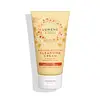What's inside
What's inside
 Key Ingredients
Key Ingredients

No key ingredients
 Benefits
Benefits

 Concerns
Concerns

 Ingredients Side-by-side
Ingredients Side-by-side

Water
Skin ConditioningPEG-7 Glyceryl Cocoate
EmulsifyingGlycerin
HumectantSodium Cocoamphoacetate
CleansingPolyglyceryl-10 Laurate
Skin ConditioningCocamidopropyl Betaine
CleansingLauryl Glucoside
CleansingRubus Chamaemorus Fruit Juice Extract
HumectantAcrylates/C10-30 Alkyl Acrylate Crosspolymer
Emulsion StabilisingDisodium Lauryl Sulfosuccinate
CleansingSodium Laureth Sulfate
CleansingSodium Cocoyl Isethionate
CleansingZea Mays Starch
AbsorbentSodium Cocoyl Glutamate
CleansingSodium Lauryl Glucose Carboxylate
CleansingCetearyl Alcohol
EmollientSodium Benzoate
MaskingPropanediol
SolventPotassium Sorbate
PreservativeHydrogenated Castor Oil
EmollientPhenoxyethanol
PreservativeTitanium Dioxide
Cosmetic ColorantSodium Hydroxide
BufferingEthylhexylglycerin
Skin ConditioningParfum
MaskingWater, PEG-7 Glyceryl Cocoate, Glycerin, Sodium Cocoamphoacetate, Polyglyceryl-10 Laurate, Cocamidopropyl Betaine, Lauryl Glucoside, Rubus Chamaemorus Fruit Juice Extract, Acrylates/C10-30 Alkyl Acrylate Crosspolymer, Disodium Lauryl Sulfosuccinate, Sodium Laureth Sulfate, Sodium Cocoyl Isethionate, Zea Mays Starch, Sodium Cocoyl Glutamate, Sodium Lauryl Glucose Carboxylate, Cetearyl Alcohol, Sodium Benzoate, Propanediol, Potassium Sorbate, Hydrogenated Castor Oil, Phenoxyethanol, Titanium Dioxide, Sodium Hydroxide, Ethylhexylglycerin, Parfum
Water
Skin ConditioningDecyl Oleate
EmollientCetearyl Alcohol
EmollientGlycerin
HumectantC13-15 Alkane
SolventSorbitan Stearate
EmulsifyingPropanediol
SolventVaccinium Myrtillus Fruit Juice
Skin ConditioningBetaine
HumectantPhenoxyethanol
PreservativeArachidyl Alcohol
EmollientXanthan Gum
EmulsifyingBehenyl Alcohol
EmollientEthylhexylglycerin
Skin ConditioningArachidyl Glucoside
EmulsifyingSodium Gluconate
Skin ConditioningPEG-8
HumectantLactic Acid
BufferingTocopherol
AntioxidantAscorbyl Palmitate
AntioxidantAscorbic Acid
AntioxidantCitric Acid
BufferingWater, Decyl Oleate, Cetearyl Alcohol, Glycerin, C13-15 Alkane, Sorbitan Stearate, Propanediol, Vaccinium Myrtillus Fruit Juice, Betaine, Phenoxyethanol, Arachidyl Alcohol, Xanthan Gum, Behenyl Alcohol, Ethylhexylglycerin, Arachidyl Glucoside, Sodium Gluconate, PEG-8, Lactic Acid, Tocopherol, Ascorbyl Palmitate, Ascorbic Acid, Citric Acid
 Reviews
Reviews

Ingredients Explained
These ingredients are found in both products.
Ingredients higher up in an ingredient list are typically present in a larger amount.
Cetearyl alcohol is a mixture of two fatty alcohols: cetyl alcohol and stearyl alcohol. It is mainly used as an emulsifier. Emulsifiers help prevent the separation of oils and products. Due to its composition, it can also be used to thicken a product or help create foam.
Cetearyl alcohol is an emollient. Emollients help soothe and hydrate the skin by trapping moisture.
Studies show Cetearyl alcohol is non-toxic and non-irritating. The FDA allows products labeled "alcohol-free" to have fatty alcohols.
This ingredient is usually derived from plant oils such as palm, vegetable, or coconut oils. There is debate on whether this ingredient will cause acne.
Due to the fatty acid base, this ingredient may not be Malassezia folliculitis safe.
Learn more about Cetearyl AlcoholEthylhexylglycerin (we can't pronounce this either) is commonly used as a preservative and skin softener. It is derived from glyceryl.
You might see Ethylhexylglycerin often paired with other preservatives such as phenoxyethanol. Ethylhexylglycerin has been found to increase the effectiveness of these other preservatives.
Glycerin is already naturally found in your skin. It helps moisturize and protect your skin.
A study from 2016 found glycerin to be more effective as a humectant than AHAs and hyaluronic acid.
As a humectant, it helps the skin stay hydrated by pulling moisture to your skin. The low molecular weight of glycerin allows it to pull moisture into the deeper layers of your skin.
Hydrated skin improves your skin barrier; Your skin barrier helps protect against irritants and bacteria.
Glycerin has also been found to have antimicrobial and antiviral properties. Due to these properties, glycerin is often used in wound and burn treatments.
In cosmetics, glycerin is usually derived from plants such as soybean or palm. However, it can also be sourced from animals, such as tallow or animal fat.
This ingredient is organic, colorless, odorless, and non-toxic.
Glycerin is the name for this ingredient in American English. British English uses Glycerol/Glycerine.
Learn more about GlycerinPhenoxyethanol is a preservative that has germicide, antimicrobial, and aromatic properties. Studies show that phenoxyethanol can prevent microbial growth. By itself, it has a scent that is similar to that of a rose.
It's often used in formulations along with Caprylyl Glycol to preserve the shelf life of products.
Propanediol is an all-star ingredient. It softens, hydrates, and smooths the skin.
It’s often used to:
Propanediol is not likely to cause sensitivity and considered safe to use. It is derived from corn or petroleum with a clear color and no scent.
Learn more about PropanediolWater. It's the most common cosmetic ingredient of all. You'll usually see it at the top of ingredient lists, meaning that it makes up the largest part of the product.
So why is it so popular? Water most often acts as a solvent - this means that it helps dissolve other ingredients into the formulation.
You'll also recognize water as that liquid we all need to stay alive. If you see this, drink a glass of water. Stay hydrated!
Learn more about Water